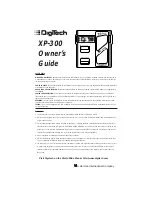
10. Check your work for solder bridges, which are particularly likely with RadioShack PCBs,
because the pads and holes are so large.
11. Test the cable.
Circuit description
The GraphLink cable has three conductors. Two of the conductors are data lines, which connect to the
tip and the ring of the 2.5mm plug. The third conductor connects to the calculator ground through the
base conductor of the plug. Each data line sends and receives data. One data line is used to transmit a
'0' bit, and the other transmits a '1' bit. The data lines are asserted low but float high, about +5V above
the calculator ground. So, if either the calculator or the PC asserts a data line, both ends of the line are
pulled low. Both data lines have a pull-down resistor of about 10Kohm in the calculator, so the
transmitting circuit must sink about 0.5mA. For the moment, assume that the two calculators (a
'transmitter' and a 'receiver') are connected with the GraphLink, then these steps are used to transmit a
data bit:
1. Initially both data lines are floating high. This is the idle state.
2. The transmitter asserts one of the data lines low, to transmit a bit.
3. The receiver asserts the other data line to indicate it has received the bit.
4. The transmitter stops asserting low.
5. The receiver stops asserting low.
6. Both calculators are back in the idle state, and the next bit may be transmitted.
Note that precise timing is not required, because this is an asynchronous data link.
Since the GraphLink is designed for communications between two calculators, the purpose of the
GraphLink cable circuit is to use the computer's serial port to emulate a calculator. This is
accomplished with five of the serial port pins. The RX and TX lines do not receive and transmit data, as
is usually the case with RS-232 communications. Instead, the TX line is perpetually set to its low
voltage state, and sinks current from the cable circuit. The RX line is not used at all. The RTS and DTR
lines are used to transmit data from the PC, and the CTS and DSR lines receive data from the
calculator. Since the upper and lower halves of each BCC link circuit are identical, we need only
describe the upper half.
This table describes the four conditions the BCC circuit must apply.
LOW
LOW
Yes
#4
LOW
HIGH
Yes
#3
LOW (plug tip 0V with respect to
calculator ground, CTS negative with
respect to serial port ground.)
LOW (Negative voltage with
respect to serial port ground)
No
#2
HIGH (plug tip 5V with respect to
calculator ground, CTS positive with
respect to serial port ground).
HIGH (Positive voltage with
respect to serial port ground
No
#1
Result at data line (Plug tip and CTS)
State of RTS line
Calculator
asserting
Low?
Case
In cases 3 and 4, the calculator is either transmitting a data bit or acknowledging receipt of a bit, so,
regardless of the state of the RTS line, the CTS line must be low so that the PC reads the low level. In
5 - 9
Summary of Contents for TI-92+
Page 52: ...Component side of PCB GraphLink I O connector detail 1 41...
Page 53: ...LCD connector detail PCB switch side 1 42...
Page 54: ...Key pad sheet contact side Key pad sheet key side 1 43...
Page 55: ...Key cap detail 1 44...
Page 57: ...Component side of PCB with shield removed A detail view of the intergrated circuits 1 46...
Page 410: ...void extensionroutine2 void Credit to Bhuvanesh Bhatt 10 4...
















































